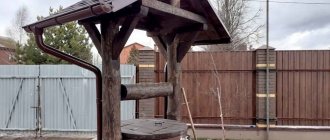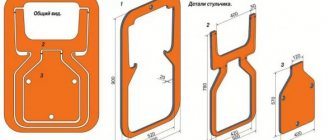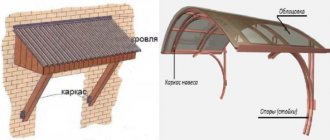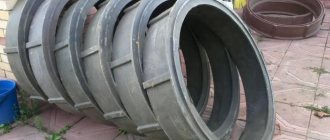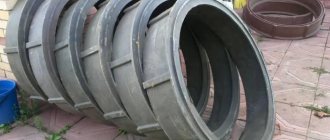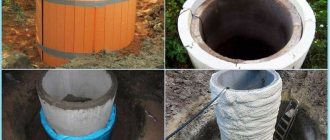The use of special reinforced concrete blocks when constructing a well shaft on their own forces summer residents to think about how to lower the rings into the well without a tap. Following the builders' recommendations while observing safety requirements will allow you to complete the procedure yourself.
Loading concrete rings into the well.
Choosing a site for construction
First you need to decide on your place of work.
A number of factors are taken into account. Thus, construction near sources of large pollution is prohibited, otherwise water, passing through the upper layers of the earth, will absorb harmful substances. These may be garbage pits or wastewater collection points. Building a well is not always profitable. In this case, the hydrological factor is taken into account. In swampy areas, well water cannot be used.
Before starting work on arranging a well, you should decide on a place on the site
In addition, it is important to pay attention to the topography and type of soil. So, on a slope, getting to the water will be problematic. The location should be as close as possible to the place of consumption
In addition, this will reduce the cost of water supply. But placing the source close to home is also not recommended. An interval of 5 m should be observed. The choice of time to dig a well requires special attention:
The location should be as close as possible to the place of consumption. In addition, this will reduce the cost of water supply. But placing the source close to home is also not recommended. An interval of 5 m should be observed. The choice of time to dig a well requires special attention:
- Spring. Time of active snow melting. It is not recommended to dig at such a time, because you can make mistakes when choosing the depth. It all depends on the increase in the height of groundwater passage. The depth will be insufficient, and the well will dry up in the cold season.
- Winter. It is considered the best time to carry out such work. More precisely, the end of winter. At this time, the water level is lowest. But in cold weather it is difficult to carry out work. But only in winter can you dig a well in places passing through the floating pond.
- When setting up deep mines, a lot of temporary resources are required. And work should be carried out without interruptions. This is why you will need to manage your time correctly.
Construction will require at least three workers. One works in the mine with a shovel, filling containers with earth. The second worker pulls out and carries the buckets. The third one replaces the tired one. The main thing is to do everything quickly.
Cleaning the mine after work
Upon completion of the increase in production, cleanup measures are carried out for further operation of the source:
- the walls of the column are cleaned of moss, dust deposits and clay deposits using a metal brush;
- the seams are insulated with a mixture of cement and liquid glass;
- for disinfection, treat with a solution of bleach;
- pump out the accumulated water and lay a drainage layer of crushed stone on the bottom;
- Keep the source closed for a day and pump out the water again.
After filling with water, the mine can be operated.
We begin to independently increase production after studying the safety rules for working in a mine, the experience of craftsmen who talk in video materials about the methods of immersing wells, and participating in work with professionals.
Comparison of wells made of plastic and concrete rings
Concrete as a material for wells has both advantages and disadvantages. The main advantage is that concrete and reinforced concrete rings for wells have a lower cost compared to analogues made of polypropylene, polyvinyl chloride and polyethylene.
The disadvantages that significantly limit the use of concrete rings include the complexity of installation. There is no way to do this without a crane and heavy special equipment. In addition, concrete rings are produced in standard sizes, which significantly limits their use. Here you can see the weight of the concrete ring for the well.
Now let’s list the advantages of plastic rings:
- Their main advantage is their low weight. Replacing a ring weighing 40 kg can be done by two normal men. Therefore, if the agenda is to build a well in your dacha or in your yard without involving a large number of people and equipment, then plastic rings are the only right solution.
- Due to the low weight, there is a second advantage - the ability to deliver the rings by your own transport to any place in your personal plot.
- Polymers are plastic materials. If, for example, water in a concrete well constantly freezes and thaws, then, in the end, this will render it unusable. Plastic wells are not sensitive to rapid changes in temperature, as well as increased soil vibration. So in some places (near the highway, working mechanisms) plastic rings are an alternative that will allow the well to go without repair for a long time.
- The ease of installing plastic cannot be compared with installing concrete rings. Polymers can be cut, sawed, sanded and bent. Therefore, each well made of plastic rings is customized to the specific needs of the customer.
- Thanks to the threaded connections, the plastic rings are tightly screwed onto each other. Special impregnations and mastics complete the 100% tightness.
The variety of polymer wells knows no bounds. In addition, you can always order an individual project, which will not cost much more than a standard one. The ease of working with plastic and the relative cheapness of its production allows us to talk about a new era in building materials.
Prefabricated plastic rings have a guarantee of 50 years. But even if something happens and one of the rings of the sewer, drainage or drinking well is damaged, it can always be replaced. Screw connections make dismantling and installing new elements much easier.
Types of plastic wells
Sewer. If there is no centralized sewage system at the dacha or there is no desire to install a storage septic tank, then a plastic sewer well will always help out. Install special kinets at the bottom through which the liquid will flow into the soil. Drainage or absorption. This is a type of sewer well. You can do without a chute, but you need to put a bed of gravel and sand on the bottom. Classic drinking. Here, plastic can be used not only at the initial stage of constructing your own water source. With the help of prefabricated plastic rings, you can “reanimate” an old concrete structure. Leaks at the joints of reinforced concrete rings, unpleasant odors from the depths of the well, clogging of the aquifer and other problems can be solved by restoration. This process is also called “rehabilitation.” To do this, take plastic rings of a smaller diameter than the former well and sequentially screw one on top of the other. A cushion of sand and cement is poured between the concrete walls and plastic rings. A filter of fine-grained gravel and sand is poured onto the bottom. As a result, there is no need to dig a new well, which saves tens of thousands of rubles. Cumulative. This type of well is adapted for collecting rainwater and using it for irrigation.
It is important to ensure the tightness and reliability of the butt joints, because the water here will be above the aquifer. The strength characteristics of plastic rings for wells allow them to withstand significant pressure and mechanical loads in any direction
Observations. They are designed for monitoring and repairing sewer systems. They are equipped with ladders, handrails and other devices for the convenience of operating personnel.
To deepen or not to deepen?
Drilling a dry well with your own hands is a very difficult and costly task, both in time and money. That is why it is extremely important to determine the feasibility of a future event.
First of all, you need to answer a few questions:
- A decrease in the amount of water in the well cannot be associated with the weather: prolonged frosts or prolonged drought.
- The water remaining in the well retained its quality. It has no foreign odors, is tasty and clean. If this is not the case, the bottom filter may become silted. The problem can be solved by proper cleaning.
- The water level in nearby wells has not changed.
If the answer to all questions is positive, it is quite possible that the problem is in your well, and it needs to be deepened. But there is still no need to rush to start work.
To begin with, it makes sense to carry out the following activities:
- conduct geological exploration by interviewing neighbors - owners of wells or wells;
- accurately determine the daily water flow;
- find out from the meteorological service or from the owners of exploited water sources at what depth their aquifer is opened;
- determine the ability of the soil to “hold” the walls of the mine without settlement.
Such labor-intensive preparatory work is due to the fact that all types of soil have their own characteristics and are characterized by certain nuances during work. Violation of technology and incompetence of the employee can lead to the blocking of the aquifer, or even destruction of the trunk when it gets into quicksand.
Quicksand is soil consisting of a water-saturated mixture of sand, organic matter and silt, which under certain conditions begins to move, which is dangerous not only for the well, but also for nearby buildings.
Mistakes in deepening a well shaft can be costly, both in terms of labor and money. The procedure can be carried out only once and if it fails, the only thing left to do is fill up the well.
At the same time, the cost of a new well dug nearby in some cases may turn out to be less than deepening the old one, and no one can guarantee success.
Experts recommend deepening the mine if several conditions exist:
- There is no quicksand at the bottom of the trunk.
- The well shaft is very deep, at least 10 rings. Otherwise, building a new structure will cost less.
- Good quality of water at the source.
- No deformation of concrete rings inside the trunk. If there are displacements, their value does not exceed 40 mm.
- The daily water flow is less than one ring.
The well will have to be deepened to the second aquifer. This is at least 5 meters, and there are no guarantees that the water in it is suitable for drinking.
Typical sizes of reinforced concrete rings
If for some reason you cannot use ready-made products, then the owner of a country or summer cottage should think about options for making them yourself.
To do this, you need to make a mold from available materials, install a reinforcing mesh into it, and then pour in a concrete solution mixed in strictly defined proportions.
Factories producing reinforced concrete products and structures use special product markings. Well rings of standard size have the same height, equal to 900 mm. The thickness of the cylinder wall and its diameter may vary. The wall thickness varies from 70 mm to 140, and the diameter - from a meter to two.
The main dimensional parameters of a reinforced concrete ring for a well: Dв - internal diameter, Dн - external diameter, H - height
With an increase in the diameter of the ring and the thickness of its walls, the consumption of concrete increases. The weight of the product also depends on these dimensions. To reduce the mass of the finished product, they try to reduce only the height of the reinforced concrete ring, and make the walls as thick as possible. On sale you can see products with a height of 350, 450 or 500 mm. They are also called additional rings and are installed upon completion of work, when a product of standard sizes no longer fits entirely into the dug well.
Another way to “legally” reduce the weight of a well ring is through the mandatory use of reinforcing mesh. In this case, the wall thickness can be 6-8 cm, which does not impair the strength characteristics of the product. Therefore, it is better to make reinforced concrete rings with your own hands for building a well on the site.
It is necessary to reduce the weight of the well ring in order to avoid the use of lifting equipment during installation work
This is important for summer residents and gardeners who decide not only to make products with their own hands, but also to move them around the site without the use of special equipment
Image gallery Photos from Hand-made concrete rings are most often used for the construction of water intake wells
They are very advantageous to use in the construction of inspection and rotary wells of storm and drainage sewer systems
Self-produced concrete rings guarantee cost reduction in organizing autonomous sewage systems
Short concrete rings look great as elements of landscape design of the area
Concrete rings for well construction
Rotary sewer well made of reinforced concrete ring
Construction of a septic tank made of concrete rings
Concrete rings in site arrangement
Manufacturing of reinforcing frame
The use of reinforcement makes it possible to reduce the thickness of the ring, and therefore its weight. At the same time, the strength characteristics of the product and its service life increase.
For the reinforcing frame you will need:
- steel rods with a diameter of 8-10 mm (10 pieces);
- steel wire with a diameter of 8-10 mm (about 5 m);
- thin wire.
Calculate the length of the frame. To do this, recall the formula for calculating the circumference: the number Pi (equal to 3.14, rounded to 3) must be multiplied by the diameter. We take the diameter of the circle to be 104 cm so that the frame runs in the middle of the concrete ring.
We multiply this number by 3, we get 312 cm. Divide this number by 10, we get 31.2 cm. Round up to 31 cm. So, we lay out the steel rods on a flat surface at a distance of 31 cm from each other.
Next, we weld pieces of wire 315-318 cm long to them at intervals of 160 mm. We take the wire a little longer than the calculated length of the frame, so that when rolling the workpiece into a ring, you can weld its ends or twist it.
We manually bend the mounting loops from thick steel wire and weld them to the frame (you can screw them with thin wire). That's it, the frame is ready. If you don’t have a welding machine, then all the frame elements can be twisted with thin wire.
Wire frame for reinforcing the reinforced concrete ring in Fig. B consists of steel rods, rings and four loops welded to wire. In Fig. A concrete ring without a frame with holes instead of lugs for lifting. For reinforcement, only one wire ring is laid on top of the holes (+)
Description of the septic tank
This model is supplied by a domestic manufacturer that has proven itself well in our market. A septic tank is a voluminous storage tank with thick, durable walls (up to 1.5 cm) and stiffening ribs.
The kit includes a neck for mounting the hatch, a cover and a special biological filter that provides maximum filtration of wastewater. Neck diameter 50 centimeters. Depending on the model, the device is equipped with one or two working chambers connected to each other using overflow pipes.
Septic tanks have a cylindrical shape, which ensures reliable fixation in the ground and high resistance to soil pressure. Filters are also made in the shape of a cylinder and consist of polymer fibers. A separate filter is necessarily included in large-volume products (from 4 cubic meters). This filter can be easily removed from the working chamber and washed with a stream of water. Cleaning is carried out regularly as contamination occurs - not only small, but also quite large organic residues settle on the filter fibers, which over time undergo natural rotting and disintegration into small fractions.
Characteristic features of well construction
Before building a well from concrete rings, it is important to know its structure. There are two elements in a well: an underground element and an above-ground element. Before starting work, the location of the well is determined
They begin to dig the earth to a depth that allows for the installation of water filtration, which is required to purify the water from clay, dust and other contaminants. The hydraulic structure must be protected from the penetration of wastewater, precipitation and sewage
Before starting work, the location of the well is determined. They begin to dig the earth to a depth that allows for the installation of water filtration, which is required to purify the water from clay, dust and other contaminants. The hydraulic structure must be protected against the penetration of wastewater, precipitation and sewage.
The construction of a well structure consists of 3 parts:
Installation of the head of a hydraulic structure, which is the upper part in wells located above the ground. The above-ground structural element serves as protection against the penetration of wastewater and sediments that can contaminate drinking water. It consists of a roofing part, a blind area, a canopy and a lifting mechanism. The head is decorated with: wood, stone, plaster or other facing materials
It is important to provide an element for draining rainwater, which is installed outside the head. Arrangement of shafts of hydraulic structures. This is a place located underground in the space between the top and the bottom. Water is lifted up the trunk using a bucket and rope or other lifting device
The shaft of the mine has a casing, the function of which is to protect the concrete well from destruction and penetration of groundwater into the middle of the structure. Construction of a water intake section, which is designed to store water, filter and settle it.
Water is lifted up the trunk using a bucket and rope or other lifting device. The shaft of the mine has a casing, the function of which is to protect the concrete well from destruction and penetration of groundwater into the middle of the structure. Construction of a water intake part, which is intended for storing water, filtering and settling it.
The water intake part includes a casing, a filter and comes in 3 types:
- Incomplete - this concrete structure does not have any difficulties in execution, in it the casing column does not reach the layer of impenetrable rocks and water comes from below. The imperfect design has a small water capacity and is suitable for small families.
- The complete water intake part is complex in design and has a casing that rests on a layer of waterproof rocks. The volume of part of the water accumulation is average, and the liquid is supplied through the walls of the well.
- Perfect water intake part with sump. The depth reaches one and a half meters of water reserves. Used in cases of large amounts of water consumption.
Square well
The easiest way in suburban conditions is to assemble a square formwork for a well using wood. Of course, a round well looks much more beautiful, but it is very difficult to assemble a shape for it due to the location of the fittings. For beginners, this is the most promising option. The materials you should not use are plywood sheets for square formwork. Firstly, it can be severely warped while the concrete hardens, which will greatly affect the future well. Secondly, if you take plywood, then only with a good moisture-repellent layer, and this is an expense. It is better to take non-dried boards that have lain for about a year in a covered, ventilated area. Such wood has natural moisture, so it should not in any way affect the shape of the structure during the concrete pouring process.
Recommended dimensions of one prefabricated section: 0.8 m - height, 1 m - width and 0.1 m - wall thickness. Thus, we get the following parameters:
- external formwork - 1.2 m by 1.24, panels 0.8 m high;
- internal formwork - 0.96 m by 0.96 m with a height of 0.8 m.
Each section consists of boards of selected thickness knocked together, in this case 20 mm. One section is located above the second, then the structure is completely assembled. If you want a removable option, then for more convenient assembly you can stuff metal corners on the outside of the structure in the corners. For a solid one, you can use rivets.
Afterwards, in the future well you need to place reinforcing mesh and wire every 30 cm, this will be the main condition for the rigidity of the structure. After assembling the reinforcing mesh, concrete can be poured.
The peculiarity of this method is that it is not necessary to use a vibration installation for better quality of the concrete product, since the mixture is compacted well under its own weight. After a week and a half, you can check the result. This is the simplest, but also the most unreliable way to form a well on your site.
Production of reinforced concrete structures
Reinforced concrete products are used to construct wells of various types: gas, inspection, sewer and water supply. Rigid concrete is used to make rings. There are several known technologies for the production of reinforced concrete rings for wells:
- Volumetric vibrocompression. The creation of the structure is carried out by volumetric vibrocompression of concrete products. Processing takes place in special metal forms that have the function of immediate removal of formwork. The use of a brick press increases the speed of manufacturing rings for wells. Vibrocompression significantly saves space for performing the necessary processes. The use of such an installation reduces the need for a large number of maintenance personnel. For high-quality production you will need only 2-3 people.
- Molding creation. Outdated production technology. In this case, the birth of reinforced concrete structures is carried out using metal formwork. A special form, called metal-plastic, has two cylindrical surfaces: an outer and an inner part. A concrete mixture is laid between them. When the concrete has hardened thoroughly, the metal formwork is removed. The use of injection molding technology is only possible if there are large premises, since space will be needed not only for creating products, but also for their drying and subsequent storage. Production volumes depend on the number of metal molds.
https://youtube.com/watch?v=NPLgo_RSpXw
Types of products
The round reinforced concrete structure serves as a reliable assistant during the installation of utilities. Rings are conventionally divided into several main types:
- water intake;
- collectors;
- rings intended for installation of underground cable electrical networks;
- sewer and gas pipeline concrete structures.
Also on the modern market you can find the following products:
- Overlapping rings.
- Device with a lock or with a bottom.
- Auxiliary. Made to order. With non-standard sizes. They are used in emergency situations when conventional rings are not suitable for forming a well depth shaft.
- Wall. Suitable for constructing any type of well. They participate in the formation of the neck of the created structure.
- Reinforced concrete. Actively used during installation of system communications. They will be useful during the construction of a water supply, network, gas, drainage or sewer well.
Concrete structures with different parameters are available in modern construction stores. The standard, maximum dimensions of this product are as follows: height - 100 cm, internal diameter is about 200 cm. Specific weight no more than 300 kg. The maximum wall thickness is 120 mm.
Advantages and disadvantages
Ready-made structures, like any existing building material, have their pros and cons. The strengths and weaknesses of reinforced concrete rings should be noted. Each of the advantages improves the performance of the well. Reinforced concrete products have the following positive qualities:
- Rigidity. Thanks to its rigidity, the ring can be used even on unstable ground.
- Availability of a rich and wide range of sizes.
- Concrete adapts well to any environment, so structures have a long service life. Products can perform their functions without interruption for 100 years.
- They speed up and facilitate the process of installing a sewer or water supply system.
- High quality and reasonable price.
- High level of tightness. The seams fit tightly together. This eliminates the possibility of groundwater getting inside the product.
However, reinforced concrete products have their drawbacks. So, the main disadvantages of these small structures are:
- Lack of mobility. It is almost impossible to move the created water supply structure.
- The weight and dimensions of the product are also considered a disadvantage. To install reinforced concrete devices you will need special equipment. Its use requires additional material costs.
Requirements for rings
Existing wells on the sites intended for drinking water must be isolated from the ingress of contaminated water.
More details:
- Sewage wells are used to collect polluted wastewater. Protection of wastewater discharge into the ground is unacceptable. For this purpose, they are waterproofed.
- For maintenance of underground communications, technical inspection rooms have been installed. Water entering these wells is unacceptable.
Letters and numbers are used to mark rings:
- The letter index indicates the purpose of the ring.
- The numbers indicate the diameter and height of the ring.
The photo shows all the types that are used in water supply structures.
Types of well rings
Types of rings
Well rings can be made of two materials:
- Concrete.
- Polymer
Peculiarities:
- Both have excellent properties and characteristics. They are widely used for the construction of water supply wells.
- With them, the process of constructing a structure is quite simple and all actions are completed very quickly.
Types of concrete rings
The ring for a concrete well is made from:
- Concrete mortar.
- Fittings.
- Various additives that increase its strength and environmental friendliness.
GOST 8020 90 well rings come in several brands:
- KFK - rings that are used to equip a sewer well.
- KLK - rings for arranging storm sewers.
- KDK - for organizing in-channel networks - transition wells with various equipment or special transition pipes.
- KLV - these rings are universal, as they can be used for water supply and storm wells.
- KVG - designed for the construction of gas and water supply wells and networks.
According to their characteristics, reinforced concrete rings can be:
- KO - support rings.
- KD - additional ones.
- KS - wall.
- KPN - ring with a bottom.
- There are also rings with a quarter and floor slabs: Gearbox, K 10 10.
More details:
- Support rings for wells are needed if a hatch will be constructed in the future. They are installed in front of the floor slab and can ensure reliable fastening of the hatch.
- Wall rings for wells are ordinary reinforced concrete rings, which are installed on top of each other during the construction of the well. All joints must be filled with concrete mortar to ensure their reliable fastening.
Additional rings
- Castle wells are very similar to ordinary concrete wells. Their main difference is that they have a special lock. They are also called tongue-and-groove. In addition to the lock on the upper part, there are special ridges on the lower part. The design, which is assembled from this type of rings, is distinguished by its strength.
- There are also certain holes that are filled with concrete during installation. All of them, when securely fastened, are not capable of horizontal shifts. Reinforcement also takes part in their production, which gives them greater strength.
- Rings with a bottom are not particularly complex in their design, since they are made like wall rings, only they are additionally equipped with a bottom. Accordingly, during construction they are laid on the bottom of the structure and serve as a support for it.
- There are also adjustment rings for wells. They are used to increase the depth of the well in the range of 50 cm. This allows you to obtain cleaner water. They are made of reinforced concrete or PVC.
Polymer rings for wells
These rings are also manufactured in accordance with GOST.
They:
- More practical.
- They are light in weight.
- They can be of similar types as concrete ones.
- They are most often used for the construction of sewer wells, as they are easily assembled into ready-made polymer structures with a bottom.
How much does a well ring of this type cost:
- The price of polymer rings is lower than that of concrete ones.
- This is due to the versatility of the plastic used for their manufacture.
- You can easily lift the rings with your own hands and do not use special equipment, as when installing reinforced concrete rings.
Ring sizes:
- Inner diameter - 50-60-70-80 cm.
- Height - 10-70 cm.
Types of polymer rings:
- Additional ones.
- Wall.
- Supporting.
- With a bottom.
- With floor slab.
- With or without a lid.
Only in this case, the rings with the bottom are more airtight than reinforced concrete structures of the same type. Many professionals recommend replacing the old method of constructing a well with reinforced concrete rings, with a newer one using polymer rings.
Unusual design examples
In addition to traditional installations, there are original options that will become the accent of the site. For example, a well in an oriental style: it looks like a pagoda - with a characteristic bell roof or a 4-6 pitched canopy.
Another option is a hut. From a distance the structure looks like a small house. A window or door is used as a hatch to collect water.
Another idea is nautical style. Instead of a curved handle, a steering wheel is attached to the thread, the chain is replaced with a cable, and the body itself is made in the form of a ship's bow.
Features of using plastic rings for wells
Separate plastic rings are used to assemble a single well shaft structure. They allow installation work to be completed in the shortest possible time, while reducing overall labor costs by at least half.
In addition, home owners are given the opportunity, with the help of such plastic components, to equip the necessary hydraulic structures in rather difficult climatic conditions, as well as in wet soils, which are subject to deep freezing in winter in regions with low temperatures. Such conditions negatively affect other design options, especially in cases where they are assembled from reinforced concrete rings. Even not very strong movements in the soil layers can contribute to their shift, which can lead not only to damage to the walls and violation of the tightness of the shaft, but also to the failure of expensive equipment installed in the well.
The modern trend in the quick and high-quality construction of various wells is assembly from plastic rings
Depressurization of the walls of a well used as a source of water creates a high probability of its rapid contamination and deterioration, necessitating frequent disinfection. The use of high-quality rings made of plastic solves this problem, since there are reliable ways to connect individual sections into a single sealed structure.
A two-chamber septic tank made of plastic rings - with a sealed container for accumulation and sedimentation of wastewater, and with a perforated one - for removing purified water into the drainage.
Plastic rings are used to equip well shafts intended for the following needs:
- For the construction of a conventional water well, a source of water. Not all ring models are suitable for this purpose.
- For the construction of chambers for local treatment facilities - cesspools and septic tanks.
- For storage wells of storm sewer systems.
Arranging a caisson for a well using plastic rings
- For inspection (inspection) wells at junctions of streams, turns, elevation changes, on straight sections at certain distances, etc.
- Caissons above the well for installing automatic pumping equipment in them, protecting the well from atmospheric pollution.
As you can see, the scope of application is very wide, covering, perhaps, the entire variety of hydraulic structures in a private house.
Type and structure
If you have decided on the location, all that remains is to choose what kind of mine you will make your mine. You can only dig a mine well, and you can drill an Abyssinian well. The technology here is completely different, so what follows will be about the mine well.
Well shaft type
The most common one today is a well made of concrete rings. Common - because it's the easiest way. But it has serious drawbacks: the joints are not at all airtight and through them rain and melt water enters the water, and with it what is dissolved in it and what has drowned.
Disadvantage of a well made of rings and logs
Of course, they try to seal the joints of the rings, but the methods that will be effective cannot be used: the water must be suitable at least for irrigation. But simply covering the connections with a solution is very short-lived and ineffective. The cracks are constantly increasing, and then through them not only rain or melt water enters, but also animals, insects, worms, etc.
There are rings with a lock. Between them, they say, you can lay rubber gaskets that will ensure tightness. There are rings with locks, but they are more expensive. But gaskets are practically never found, as are wells with them.
The log mine also suffers from the same “disease,” only there are even more cracks. Yes, that's what our grandfathers did. But, firstly, they had no other way, and secondly, they didn’t use so much chemicals in the fields.
From this point of view, a mine made of monolithic concrete is better. It is cast right on site using removable formwork. They poured out the ring, buried it, put up the formwork again, stuck in reinforcement, and poured another one. We waited until the concrete “set”, removed the formwork again, and started digging.
Removable formwork for a monolithic concrete well
The process is going very slowly. This is the main drawback. Otherwise there are only positives. Firstly, it turns out very cheap. The costs are only for two galvanized sheets, and then for cement, sand, water (proportions 1: 3: 0.6). It's much cheaper than rings. Secondly, it is hermetically sealed. No seams. Filling occurs approximately once a day and due to the uneven upper edge the result is almost a monolith. Just before pouring the next ring, scrape off the surface of the raised and almost set cement laitance (a gray dense film).
How to identify an aquifer
According to the technology, the soil is removed inside the ring and under it. As a result, under its own weight, it settles. This is the soil that you take out and will serve as a guide.
As a rule, water lies between two waterproof layers. Most often it is clay or limestone. The aquifer is usually sand. It can be small, like seaweed, or large interspersed with small pebbles. Often there are several such layers. As the sand goes, it means water will appear soon. Once it appears at the bottom, you need to dig for some more time, removing the already wet soil. If the water is coming actively, you can stop there. The aquifer may not be very large, so there is a risk of going through it. Then you'll have to dig until the next one. The deeper the water will be cleaner, but how much deeper is unknown.
Next, the well is pumped - a submersible pump is inserted and the water is pumped out. This cleans it, deepening it a little, and also determines its flow rate. If the rate at which the water rises suits you, you can stop there. If it’s not enough, you need to quickly go through this layer. With the pump running, they continue to remove soil until they pass through this layer. Then they dig until the next water carrier.
Bottom filter in a well
Bottom filter device for a well
If you are satisfied with the speed of incoming water and its quality, you can make a bottom filter. These are three layers of cameos of different fractions, which are laid on the bottom. They are needed to ensure that as little silt and sand gets into the water as possible. In order for the bottom filter for a well to work, the stones must be laid out correctly:
- Large stones are placed at the very bottom. These should be quite large cobblestones. But in order not to greatly reduce the height of the water column, use a flatter shape. Lay them out in at least two rows, and do not try to have them stand close together, but with gaps.
- The middle fraction is poured in a layer of 10-20 cm. The dimensions are such that stones or pebbles do not fall into the gaps between the lower layer.
- The top, smallest layer. Pebbles or small stones in a layer of 10-15 cm. Sand will settle in them.
With this arrangement of fractions, the water will be cleaner: first, the largest inclusions settle on large stones, then, as you move up, smaller and smaller ones.
Deepening a well with your own hands: a review of the best methods to “get to the bottom” of the aquifer
Wells have been used by mankind since ancient times. The technology of their construction has been perfected over centuries and remains almost unchanged. The problems faced by the owners of such structures remain unchanged. One of the most common is reducing the amount of water.
Often the only solution is to deepen the wells to the next aquifer. We will tell you how and in what way the water intake excavation is deepened. You will find out what you will need to stock up on to carry out the work.
Production technology
Making reinforced concrete rings is a labor-intensive process that requires certain skills and knowledge. Therefore, for the construction of a small well, it is more advisable to purchase ready-made concrete products. You should know that the formwork for the rings is quite complex in its structural design. Casting work requires precision and accuracy. Compliance with the rules will avoid unevenness, loss of strength and the formation of voids in concrete. The main stages of ring production are described below.
Preparation of materials and tools
Required materials for formwork: two barrels and window awnings.
For formwork you will need:
- two steel barrels of different sizes;
- door or window awnings;
- fastening fittings;
- “pencil” for metal;
- grinder, cutting disc.
To prepare the solution:
- ready-made dry mortar or individual ingredients for mortar;
- concrete mixer;
- a bucket with which to measure the required volume;
- vibration compactor.
Basic requirements for the production process
- It is necessary to ensure sufficient strength of the collapsible form for the concrete rings.
- High-grade mixture not lower than M500.
- Fine aggregate - crushed stone with a grain size of 0.5-1 cm, washed sand.
- High-quality vibration compaction.
- Heating during operation at temperatures up to 5 0C.
Construction of formwork and frame
The outside of a cylindrical barrel is marked with two longitudinal “pencil” lines across the metal in half. Two door or window awnings are attached to the marked lines. Their bends must coincide with the drawn line. The same marking is applied from the inside of the cylinder, along which an incision is made with a grinder. This allows you to make the formwork drop-down. Fastening fittings are used to connect the halves.
The second cylindrical barrel should be smaller than the first. The same marks are made on it as on the first one with a distance between the lines of 1/3 from each other along the circumference. Canopies and spindles are also attached. The cylinder is cut along one line. The hinged parts must be assembled so that the inside of the structure is 5-10 cm higher than the external formwork.
The cylinders should open: the top one - outward, the inner one - inward. A reinforcing frame made of steel reinforcement or metal mesh is poured with concrete in the support ring, forming a strong reinforced concrete layer.
Filling with composition
To prepare the pour, you can use a ready-made concrete mixture or make it yourself. In the latter case, it is customary to take the ratio of cement to crushed stone and sand equal to 1: 1: 3. The volume of water is determined visually so that the solution is evenly distributed inside. The liquid is added in parts with thorough mixing.
The finished concrete solution is poured in portions. Each layer is carefully compacted. To do this, it is better to use a special vibration device. The large weight requires installation by a crane, so four mounting loops with a cross-section of 8-10 mm are installed in the reinforced concrete rings at the molding stage. The ends of the wire are bent and buried in concrete at a distance of 40-50 cm.
Seal
The entire volume is qualitatively compacted to remove air, which increases the strength of the finished product. Bayoneting or tamping with a rod partially solves the problem. In the absence of a vibrating platform, the use of a conventional hammer drill is allowed. To do this, instead of a peak, a reinforcement with a metal plate welded to its end is clamped.
Dismantling
The bolts of the external formwork are loosened. To make the mold easier to separate, the walls are tapped with a hammer. The inner part will be easier to remove if you first place two square pipes in it. After the concrete has thickened and hardened, these parts are simply knocked out of the concrete mold.
Useful video on the topic
In the video clip, the master independently assembles a metal form, coats its walls with waste oil, prepares a concrete solution and fills the formwork. Using special equipment, the mixture in the mold is carefully compacted so that there are no defects in the walls of the well.
The video shows how it is easier to remove the formwork, starting from the inner ring. By the way, the well ring is made without a reinforcing frame, so the thickness of the product is at least 15 cm.
In this video, the mold is designed to cast a thinner reinforced concrete ring. The master uses steel wire as reinforcement. The story shows in more detail the process of putting ingredients into a concrete mixer.
As you can see, any healthy man can make reinforced concrete rings for a well. No special skills are required in making molds and mixing concrete mortar.
You can watch little tricks in videos on this topic. In a month, a person can cast up to ten reinforced concrete rings using one mold. This is quite enough to equip a well shaft. Its depth depends on the level of the aquifer in your area.
Do you have experience making concrete rings? Please share information with our readers, tell us about the features of your method. You can leave and ask questions about the topic of the article in the form below.
How and from what to make molds for concrete rings
Factory molds are made of sheet metal and reinforced with stiffeners. Metal thickness is 3-8 mm depending on the dimensions of the ring.
Molds for well rings are most often made of metal
From thick-walled barrels
At home, bending sheet metal with the required radius of curvature is not at all easy. It is much easier to find two thick-walled barrels with different diameters. The diameters should differ by 14-16 mm. In this case, the wall thickness will be 7-8 mm. For a well ring with reinforcement, this is what is required.
To make it easier to work with the mold for reinforced concrete rings, you can fasten the two halves together with door hinges
The bottom of the barrels is cut off, the inside is made higher by about 10 cm - this is more convenient. To be able to remove the formwork from the finished ring, the barrels are sawn lengthwise into two parts. The halves must be connected securely. You can do this in different ways:
- Having welded the corners with drilled holes, tighten them with bolts;
- make “ears” into which to drive wedges.
To prevent the inner part from leading, several spacers must be welded to each half, which will keep the walls from bending.
Having inserted one part of the formwork into another, they are placed at the same distance from one another (measuring the gap in a circle). Holes are drilled in several places for the studs with which they will be secured. Studs are pieces of rod with threads on both sides. The holes are placed one opposite the other so that parts of the formwork can be securely fixed.
Studs are inserted into the drilled holes and tightened with nuts. If the walls of the mold for concrete rings are not very thick, you will most likely have to place large washers or metal plates with holes cut out of metal under the nuts so that the mold does not bend when pouring concrete.
Sheet metal
If desired, you can make forms for concrete rings from a strip of sheet metal and wooden blocks, which will give rigidity to the formwork. Cut the strip to the required length - along the circumference + 10 cm for the connection. The width of the strip is equal to the height of the ring + 10 cm. Bend the sides 5 cm at the bottom and top, and make the same side along the edge of the strip. Drill holes in the side panel for the tightening bolts. Cut the top side every 20-25 cm (less if the diameter of the ring is small). Now the strip can be bent to create a ring. But it is very unstable - it “plays”. Rigidity can be added using a wooden frame.
Molds for concrete rings can be made from sheet steel
From the bar, cut pieces 20-25 cm long. Attach them under the side, drill a hole in the metal, screw sections of bars onto self-tapping screws. With a length of bars of 20-25 cm, the shape will not be round, but multifaceted. If this is critical for you, you can make cuts more often and cut the bars shorter. The height also needs to be strengthened. Bars are also used for this. They need to be fastened more often so that the walls do not sag.
If you know how to use welding, you can go the other way. In addition to sheet metal, you will need a profiled square pipe. 15*15 mm or 20*20 mm will do. First you need to bend four identical half-arcs from a profile pipe. Four large ones are for external formwork and four smaller ones are for internal formwork. Weld cut strips of metal to the arcs.
How to use arches from a profile pipe as a basis
